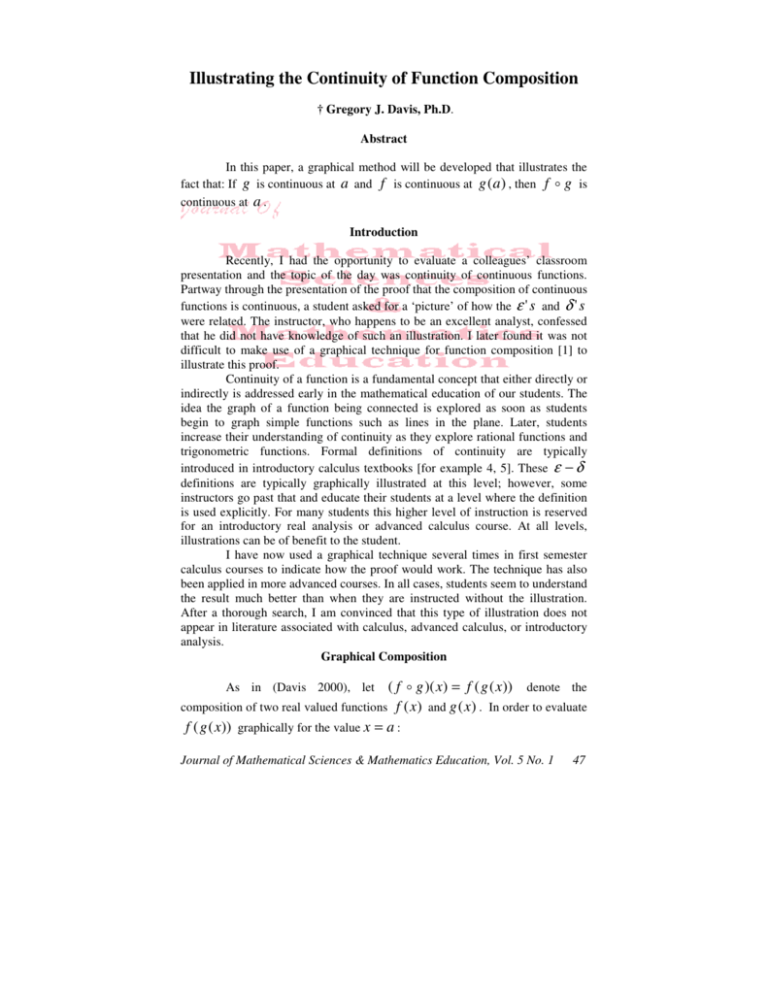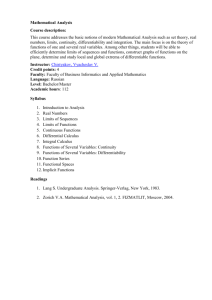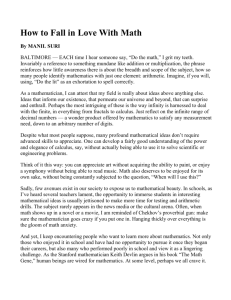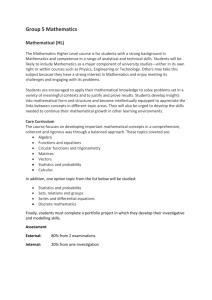
Illustrating the Continuity of Function Composition
† Gregory J. Davis, Ph.D.
Abstract
In this paper, a graphical method will be developed that illustrates the
fact that: If g is continuous at a and f is continuous at g (a ) , then f g is
continuous at a .
Introduction
Recently, I had the opportunity to evaluate a colleagues’ classroom
presentation and the topic of the day was continuity of continuous functions.
Partway through the presentation of the proof that the composition of continuous
functions is continuous, a student asked for a ‘picture’ of how the ε ' s and δ ' s
were related. The instructor, who happens to be an excellent analyst, confessed
that he did not have knowledge of such an illustration. I later found it was not
difficult to make use of a graphical technique for function composition [1] to
illustrate this proof.
Continuity of a function is a fundamental concept that either directly or
indirectly is addressed early in the mathematical education of our students. The
idea the graph of a function being connected is explored as soon as students
begin to graph simple functions such as lines in the plane. Later, students
increase their understanding of continuity as they explore rational functions and
trigonometric functions. Formal definitions of continuity are typically
introduced in introductory calculus textbooks [for example 4, 5]. These ε − δ
definitions are typically graphically illustrated at this level; however, some
instructors go past that and educate their students at a level where the definition
is used explicitly. For many students this higher level of instruction is reserved
for an introductory real analysis or advanced calculus course. At all levels,
illustrations can be of benefit to the student.
I have now used a graphical technique several times in first semester
calculus courses to indicate how the proof would work. The technique has also
been applied in more advanced courses. In all cases, students seem to understand
the result much better than when they are instructed without the illustration.
After a thorough search, I am convinced that this type of illustration does not
appear in literature associated with calculus, advanced calculus, or introductory
analysis.
Graphical Composition
( f g )( x) = f ( g ( x)) denote the
composition of two real valued functions f (x ) and g (x ) . In order to evaluate
f ( g ( x)) graphically for the value x = a :
As in (Davis 2000), let
Journal of Mathematical Sciences & Mathematics Education, Vol. 5 No. 1
47
On the same set of axes draw the graphs of y
y = x.
Draw a vertical line from the point
on the graph of y
= f (x) , y = g (x) , and
x = a on the x-axis to the point (a, g (a ))
= g (x) .
Draw a horizontal line from (a, g ( a )) to the point ( g ( a ), g ( a )) on the line
y = x.
Draw a vertical line from ( g ( a ), g ( a )) to the point ( g ( a ), f ( g ( a ))) on the
graph of y
= f (x) .
Draw a horizontal line from ( g ( a ), f ( g ( a ))) to the point (0, f ( g ( a ))) on
the y-axis.
Continuity of Composed Functions
A typical proof of the continuity of composed functions is as follows [for
example 2, 3].
Since g is continuous at a , g (a ) is defined; likewise, f is continuous at
g (a ) , so f ( g (a )) = ( f g )(a ) is defined. At this point, using the
instructions above, a picture of f ( g ( a )) is drawn, see Figure 1.
An
ε −δ
proof is now used to show
lim( f g )( x) = f g (a ) ; i.e., given
x→a
ε > 0 , δ > 0 must be found to satisfy:
If x − a < δ , then f ( g ( x )) − f ( g ( a )) < ε .
Due to the continuity of
If
f at g (a ) , we know there is a δ 1 , such that:
z − g (a) < δ 1 , then f ( z ) − f ( g (a )) < ε .
Hence when
g (x) is within δ 1 of g (a ) , then f ( g (a )) is within ε of
f ( g (a )) ; i.e.,
g ( x) − g (a) < δ 1 , then f ( g ( z )) − f ( g (a)) < ε .
Since g is continuous at a , there is a δ > 0 , such that:
If
If
x − a < δ , then g ( x) − g (a) < δ 1 .
Chaining inequalities together completes the proof:
x − a < δ g ( x) − g (a) < δ 1 f ( g ( x)) − f ( g (a)) < ε .
The Illustration
To draw the corresponding illustration, the following procedure is
carried out:
Journal of Mathematical Sciences & Mathematics Education, Vol. 5 No. 1
48
As in Figure 2, draw an ε − neighborhood, on the y-axis, about the point
f ( g (a )) .
As in Figure 3, draw horizontal lines from the boundaries of this neighborhood
to the curve y = f (x ) .
As in Figure 4, draw two vertical lines from these locations to the line y = x .
Since the
ε − neighborhood includes f ( g (a )) , the vertical lines intersect the
y = x above and below the value of g (a ) .
As in Figure 5, draw a δ 1 − neighborhood about g (a ) , that when extended to
the line y = x , remains inside the region associated with the
ε − neighborhood.
As in Figure 6, extend the δ 1 − neighborhood horizontally to the curve
y = g (x) .
line
As in Figure 7, draw horizontal lines from these boundaries to the x-axis. These
lines will define an interval that has x = a in its interior.
As in Figure 8, draw a δ − neighborhood about x = a , that remains inside the
previous interval.
As in Figure 9, the boundaries of the δ − neighborhood are graphically
evaluated by g and then f .
The resulting neighborhood on the y-axes remains within
desired and the illustration is complete.
ε
of
f ( g (a )) as
Conclusion
I have found that this method of illustrating that the composition of
continuous functions is continuous requires no significant additional classroom
time. It has proven to be a very helpful teaching aid in the classroom. Students
seem to have a better understanding of both function composition as well as the
associated continuity properties. I also find that students who have been exposed
to this graphical method are more likely to be able to understand how to make
choices for ε and/or δ in specific computational exercises. I expect that others
will find this type of illustration helpful as well.
Journal of Mathematical Sciences & Mathematics Education, Vol. 5 No. 1
49
Journal of Mathematical Sciences & Mathematics Education, Vol. 5 No. 1
50
Journal of Mathematical Sciences & Mathematics Education, Vol. 5 No. 1
51
Journal of Mathematical Sciences & Mathematics Education, Vol. 5 No. 1
52
Journal of Mathematical Sciences & Mathematics Education, Vol. 5 No. 1
53
† Gregory J. Davis, Ph.D., University of Wisconsin – Green Bay, WI, USA
References
[1] Davis, G.J., A Graphical Method for Function Composition. Teaching
Mathematics and its Applications 2000, 19:154-157.
[2] Fitzpatrick, P.M., "Advanced Calculus", 2e. Thompson Brooks/Cole, CA,
2006.
[3] Schroder, B.S., "Mathematical Analysis: A Concise Introduction". Wiley,
NY, 2007.
[4] Stewart, J., "Calculus", 6e. Thompson Brooks/Cole, CA, 2008.
[5] Thomas, G.B., et al., "Thomas' Calculus", 11e, Pearson Addison Wesley,
NY, 2008.
Journal of Mathematical Sciences & Mathematics Education, Vol. 5 No. 1
54






